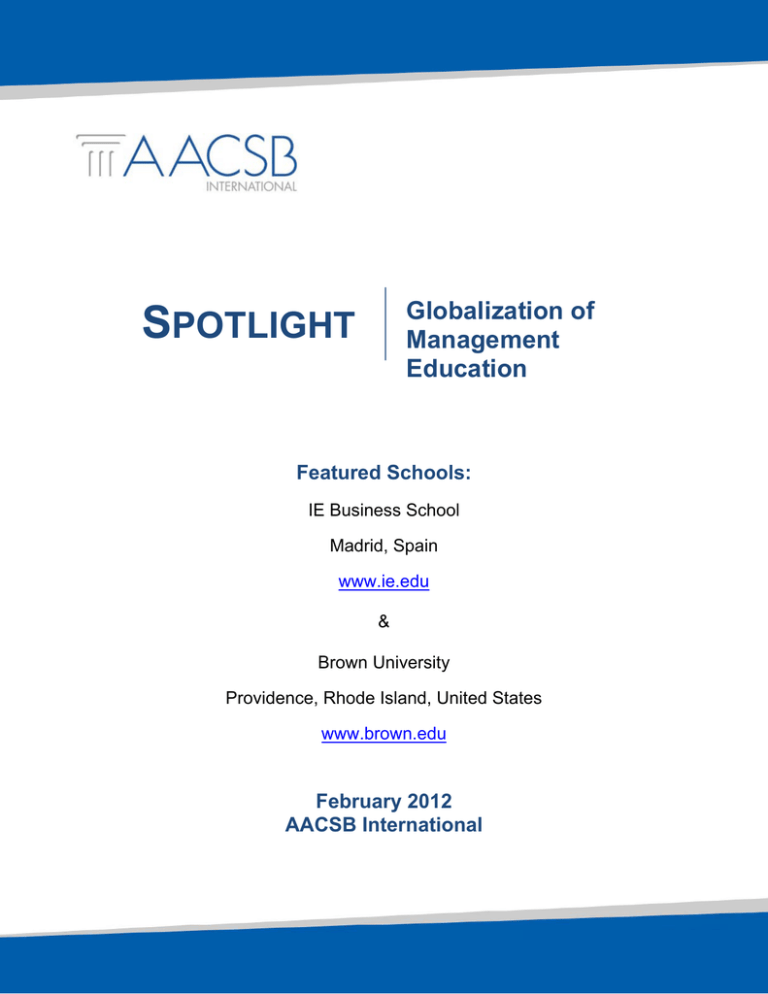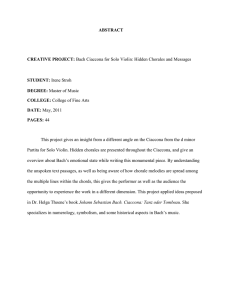
Globalization of
Management
Education
SPOTLIGHT
Featured Schools:
IE Business School
Madrid, Spain
www.ie.edu
&
Brown University
Providence, Rhode Island, United States
www.brown.edu
February 2012
AACSB International
SPOTLIGHT | Globalization of Management Education
IE Business School & Brown University | 2
IE Business School and Brown University:
A Collaboration of Complementary Strengths
The best collaborations between higher education institutions are born from mutual interest and
complementarity of strengths. Such is the case for the relationship between the IE Business School of
Madrid, and Brown University of Providence, Rhode Island. When these two renowned institutions first
began considering academic collaboration, David Kennedy, Brown’s then-vice president for international
affairs, commented, “During discussions in Spain and here in Providence, we have come to see how well
Brown and [IE Business School] complement each other.”1 Such sentiment is still very much in evidence,
as the partnership between Brown University and IE Business School has grown over the years.
David Bach, Dean of Programs at IE, says that it was serendipity that began the conversation between
the two schools right at the time that each was looking to strengthen its own offerings in areas where the
other was already strong. He recalls that back in 2007, IE had begun revamping its business curricula to
include greater content in the humanities. At the same time, Brown, one of only two American Ivy League
institutions without a formal business unit of its own, was looking to expand in the area of professional
education, without necessarily creating its own business school.2,3 Brown University Provost David
Kertzer has stated that his institution’s partnership with IE is “actually a way of not having a business
school.”4
Dean Bach says that the two schools share many values. They agree that higher education in general,
and management education in particular, needs to increase its level of globalization and the innovative
use of technology. As they looked for opportunities to combine their strengths, he says, the partners
quickly decided upon a joint-degree format executive MBA program that could take full advantage of
Brown’s “excellence in the humanities, social, biological, and physical sciences,” and IE’s AACSBaccredited management programs.5
The IE Brown Executive MBA Program
According to Dean Bach, the EMBA was an easy choice, because the executive format has more room
for pedagogical diversity and innovation than full-time MBA or specialized master’s programs do.
Additionally, it allows the targeting of senior executives that average ten or more years of management
experience, who would derive the greatest benefit from increased humanities and other interdisciplinary
content since such seasoned folk generally need the least amount of functional business training.
Students of the IE Brown EMBA program progress in lockstep through five 1- to 2-week face-to-face
training modules spaced out over 15 months, with three at Brown and two at IE.6 Between each of these
modules, they work with their professors via a variety of online distance learning tools in order to
overcome geographical and time constraints, including video conferencing, asynchronous online
discussion forums, instant messenger, online documents and Voice over IP technologies. According to
© AACSB International. All Rights Reserved.
SPOTLIGHT | Globalization of Management Education
IE Business School & Brown University | 3
Dean Bach, students typically have three online discussion forums each week, moderated by the same
professors that teach the courses in the face-to-face modules. All program courses blend face-to-face
and online delivery, which he says allows for the continuous, reflective learning style and flexible
scheduling that works particularly well for mid- to senior-level executives. All students are also expected
to develop a venture entrepreneurship (or intrapreneurship) project over the course of the program, which
is one of the few courses in the curriculum that is jointly taught by professors of both institutions.
Dean Bach describes the curriculum of the IE Brown EMBA program as approximately two-thirds
management education and one-third liberal arts education, including such areas as psychology,
philosophy, political science, anthropology, etc. This is not to say, of course, that IE does two-thirds of the
work. Indeed, Dean Bach emphasizes that each institution contributes equally from its strengths. Brown
professors have a bigger role in the delivery of the face-to-face modules, as three of the five are located
at Brown, while IE provides its tested digital distance learning technologies and handles the bulk of the
marketing for the program. He says that IE and Brown share full partnership in the areas of curriculum
planning and program execution, on both the humanities and management sides of the house.
With regard to curriculum content, Dean Bach takes care to point out that both the humanities and
management education courses to which students are exposed are carefully vetted by both schools in
terms of global perspectives and material. On the humanities side, for example, the “Political Economy of
Development” course takes a systematic look at the interplay of politics and economics in emerging
markets such as the BRIC nations, Latin America, and the Middle East. “Health, Ethics, and Society” is
another example of a course that examines the ethical, business, religious, scientific and cultural aspects
of medical topics such as organ donation from an anthropological perspective. On the management
education side, the integration of case studies, faculty members and students from all over the world
helps to provide international perspectives on the various topics covered. As is common with all of IE’s
programs, Dean Bach says, what has drawn many students to the IE Brown EMBA is the promise of such
diverse global experiences.
Indeed, the first cohort of IE Brown EMBA students, which is scheduled to graduate in June of 2012,
includes “students who represent 12 different industries and more than a dozen nationalities,”7 though
according to Dean Bach about 50 percent are American, which he says is an unusually high
concentration for one of IE’s programs. Nevertheless, he expects that future cohorts will be even more
internationally representative. Additionally, over 40 percent of the students in the first cohort are female,
which he says is the highest percentage of any IE EMBA program. The second cohort, which is
scheduled to begin in March of 2012, already looks to be similarly gender-balanced.
Tuition for the program is set at US$95,000, which Dean Bach admits can be expensive, but he says that
students have access to financial aid from both partner schools. For its part, IE Business School has set
© AACSB International. All Rights Reserved.
SPOTLIGHT | Globalization of Management Education
IE Business School & Brown University | 4
aside 20 percent of its revenues from the program for financial aid, an unusually high amount according
to Dean Bach, in order to make it acceptable to potential students from a broad range of sectors. He says
approximately 30 percent of the firms for whom the students work sponsor them through the program as
well, which he finds very gratifying, as it signifies a “strong bet on the success of the program” by these
corporations. The primary reason for the cost is simply that the program is expensive to deliver in the
chosen format. IE and Brown split the proceeds from the program’s tuition evenly, after expenses are
accounted for.
The actual master’s of business administration degree from the IE Brown EMBA program is awarded by
IE Business School, as it carries the so-called “triple crown” of business accreditation by AACSB
International, EQUIS, and AMBA. According to Dean Bach, graduates of the program do receive a
diploma from Brown University in recognition of their achievement, but he says that the partners hope to
adjust the formula for the program to move it more in the direction of a dual-degree format in the future,
versus the current joint-degree format.
Future Aspects of the IE-Brown Partnership
Brown and IE have already begun to expand upon the foundation laid by the EMBA program. The two
schools already run a joint pre-college summer program in Madrid.8 Brown undergraduates can take
advantage of paid summer internships at IE Business School.9 The partners have also begun soliciting
applications for a new junior faculty exchange program, the International Teaching Fellowship, which “will
provide those who have received a doctoral degree from Brown with an opportunity to teach in Spain
starting next September [2012].”10
Finally, according to Dean Bach, the partners plan to build on the success of the IE Brown EMBA with a
new dual-degree program, in which students will receive both an MBA from IE Business School and a
master’s degree from Brown University’s Program in Innovation Management and Entrepreneurship
(PRIME).11 He says that this format will allow for greater diversity of elective courses from both schools,
which the executive format has not, to date, permitted.
Acknowledgements: AACSB International is grateful for the assistance of David Bach, Dean of Programs
at IE Business School.
© AACSB International. All Rights Reserved.
SPOTLIGHT | Globalization of Management Education
IE Business School & Brown University | 5
End Notes
1
Today at Brown Staff. (2009) “Brown, Spanish university agree to consider academic collaborations.” Today at Brown, February 4, 2009. Electronic document, http://today.brown.edu/articles/2009/02/empresa, accessed December 9, 2011. 2
Brown University. (2012) C.V. Starr Program in Commerce, Organizations, and Entrepreneurship (COE) web page. Electronic document, http://coe.brown.edu/, accessed January 17, 2012. 3
Brown University. (2012) Program in Innovation Management and Entrepreneurship web page. Electronic document, http://www.brown.edu/academics/engineering/prime/, accessed January 16, 2012. 4
Goodman, Lawrence. (2010) “Practical Studies.” Brown Alumni Magazine, May/June 2010. Electronic document, http://www.brownalumnimagazine.com/content/view/2565/40/, accessed January 16, 2012. 5
Brown University. (2009) “Brown University and Instituto Empresa Launch Joint Initiative.” Press Release, May 6, 2009. Electronic document, http://news.brown.edu/pressreleases/2009/05/ie, accessed December 9, 2011. 6
Brown University and IE Business School. (2012) IE Brown Executive MBA, Program Structure web page. Electronic document, http://www.iebrown.com/executive‐mba‐program‐structure.php, accessed January 13, 2012. 7
Baum, Deborah. (2011) “Inaugural class begins IE Brown Executive MBA program.” Brown University News and Events webpage, March 7, 2011. Electronic document, http://news.brown.edu/features/2011/03/mba, accessed January 13, 2012. 8
IE University. (2011) “IE and Brown University launch an innovative summer course for pre‐university students from the US.” IE University News and Events web page, March 14, 2011. Electronic document, http://www.ie.edu/university/news‐events/news/ie‐and‐brown‐university‐launch‐innovative‐summer‐course‐pre‐
university‐students‐us, accessed January 16, 2012. 9
Brown University, Office of Continuing Education. (2011) IE Brown Internship Opportunity web page. Electronic document, http://www.brown.edu/ce/internship‐ie.php, accessed January 17, 2012. 10
Toobin, Adam. (2011) “Partnership allows PhDs to teach in Spain.” The Brown Daily Herald, October 11, 2011. Electronic document, http://www.browndailyherald.com/partnership‐allows‐phds‐to‐teach‐in‐spain‐1.2651004, accessed January 16, 2012. 11
Brown University. (2012) Program in Innovation Management and Entrepreneurship web page. Electronic document, http://www.brown.edu/academics/engineering/prime/, accessed January 16, 2012. © AACSB International. All Rights Reserved.






